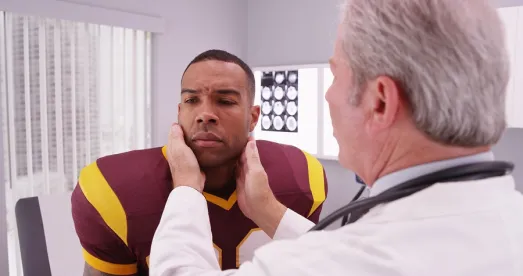When The New York Times reports that 110 out of 111 NFL brains (99.09%) have chronic traumatic encephalopathy (CTE), everyone pays attention. Mothers worry about their kids. Some worry about their jobs. Senate subcommittees investigate. The Times article covers Dr. Ann McKee’s recent article in the Journal of the American Medical Association, “Clinicopathological Evaluation of Chronic Traumatic Encephalopathy in Players of American Football” (JAMA. 2017;318(4):360-370) in dramatic fashion, illustrated with pathology slides of tissue samples from the brains of former football players and anecdotal information about them. Such claims are certain to be fuel for CTE litigation and cries to ban tackle football.
Let’s put this in perspective. About 25,000 men have played American professional football. So, 110 is roughly 0.44%. Even if the real number is double, the outcome remains a statistical nonentity.
In all fairness, the study points out some of its limitations; for example, “Ascertainment bias associated with participation in this brain donation program.” Inclusion was based entirely on exposure to repetitive head trauma eliminating any form of “control” group, a necessary element of any scientific study. The authors also disclose that “public awareness of a possible link” between head trauma and CTE “may have motivated” some participants. Finally, the authors acknowledge that the study is not representative of the population of all American football participants, as most play only at the youth or high school level, whereas the majority of the donors played at the professional level. The study data somewhat illustrates that point: CTE was found in none of two pre−high school participants and three of 14 high school participants (21%).
Breaking It Down
The 800-pound gorilla in this room is suicide. Suicide among former football players gets major media attention (Junior Seau and Aaron Hernandez) and has spawned a cottage industry of CTE litigation against every level of the sport from NFL down to Pop Warner. The study tries to correlate neuropathology with “clinical observations” − information drawn from “retrospective interviews” with family members of deceased donors. Observations are grouped as cognitive, behavioral or mood or both, and signs of dementia. Suicide was identified as the cause of death in 10% of the study group. “Suicidality” (ideation, attempts or completion) is identified among 33% of the study group. Some might conclude that if you play football you are 33% more likely to contemplate or attempt suicide and 10% more likely to succeed.
In fact, the rate of suicide mortality among retired NFL players is substantially lower than in the general population. An investigation performed at the National Institute for Occupational Safety and Health (NIOSH) and published in 2016 (Lehman, et al.) found that among players retired since 1987, the suicide rate is 6.1 / 100,000. Among players retired since 2005, it’s 12.5 / 100,000. Among average American men, the rate since 2014 is 20.1 / 100,000. One would conclude that since 2005, NFL players are 48% less likely to commit suicide than the general population, and since 1987, 70% less likely. The study covered those who played for five years or more.
Of note, drugs are assessed by standardized mortality ratio – the increase or decrease in mortality with respect to the general population. “If playing in the NFL (for a minimum of five seasons) were treated like taking a drug, it would reduce the standardized mortality (measured 30 years later) by half!” Samadani, Brain Injury and Football, Reality v. Perception. THSCA presentation, 2016.
Similar studies have been done at the college level where the NCAA maintains a robust database. A nine-year study published in October 2015 (Rao, et al.) observed that as against a rate of 12 / 100,000 among 18−22-year-old non-college individuals, the suicide rate among college students was 7.5 / 100,000. Among male NCAA athletes, the suicide rate was 2.25 / 100,000.
Another study dispels the notion that CTE is a path to neurological deficit. Published in Acta Neuropathol, “Histological Evidence of CTE in a Large Series of Neurodegenerative Diseases” (Ling, et al., 2015) observed that (1) CTE prevalence in people with neurodegenerative diseases (11.8%) was the same as in controls (12.8%); (2) patients with CTE died at a mean age of 81 years and “most positive cases [were] likely to be clinically asymptomatic”; and (3) CTE is found under the microscope in equal proportions of healthy, normal, asymptomatic people as it is in people with dementia and other diseases. For those worried about doing the right thing by their kids, a study published in December 2016 in Mayo Clinic Proceedings (Savica, et al., “High School Football and Risk of Neurodegeneration: A Community-Based Study”) found that among 438 football players followed for 50 years, the risk of dementia was the same as for members of the chorus, glee club or band.
Facts and Findings
Fortunately, in court science matters. The notion that football causes CTE has been rejected by at least one United States District Court, the Eastern District of Pennsylvania, and the Third Circuit Court of Appeals. See In re NFL Players Concussion Injury Litig., 307 F.R.D. 351 (EDPA, 2015), aff’d 821 F.3d 410 (3d Cir. 2016). Judge Brody’s key findings, based on current scientific knowledge and affirmed by the appellate court, negate causation: (1) the study of CTE is nascent, and the symptoms of the disease, if any, are unknown; (2) medical research has not reliably determined which events make a person more likely to develop CTE; and (3) research has not determined what symptoms individuals with CTE typically suffer from while they are alive. In re NFL Players Concussion Injury Litig., 821 F.3d at 441.
The point: Media should not lead science. The health and psychosocial benefits of athletic activity at all ages far outweigh any perceived risk. As parents, we should encourage healthy activity. As professionals, we need to peel back what the media pushes, read the literature and understand the fundamentals.
The renowned neurosurgeon, Uzma Samadani, M.D., Ph.D., FACS, graciously provided additional medical literature and keen insight for this article.
Disclosures and Acknowledgments: Tony Corleto serves as general counsel for Pop Warner football. He defends concussion litigation. The renowned neurosurgeon, Uzma Samadani, M.D., Ph.D., FACS, graciously provided additional medical literature and keen insight for this article.



 />i
/>i

